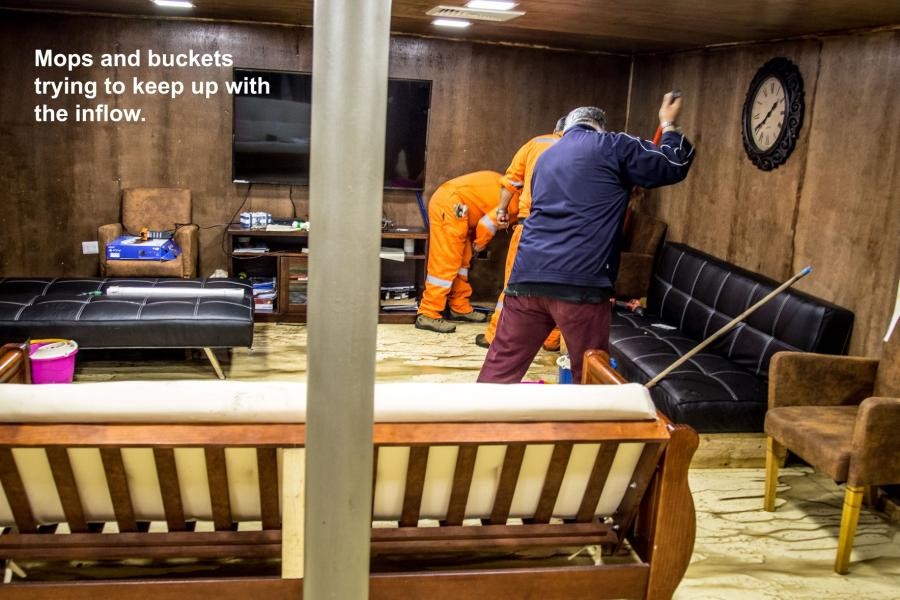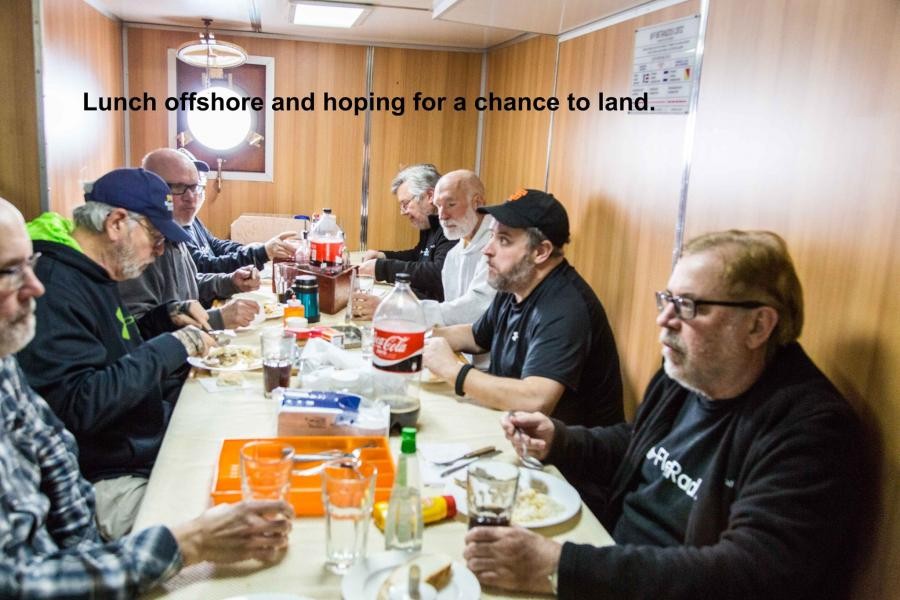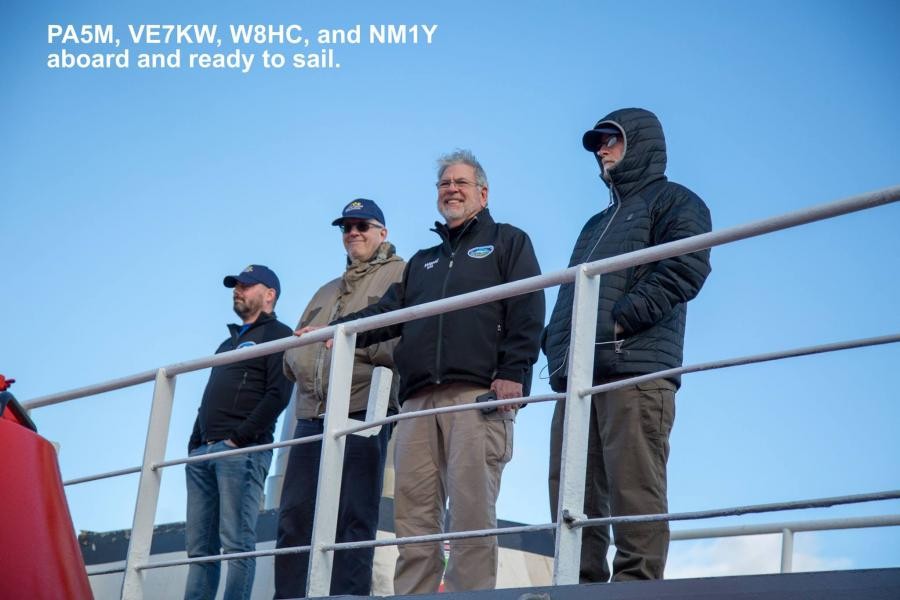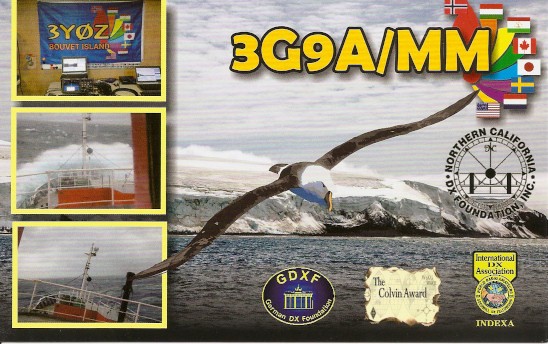3Y0Z Announcement
By K4UEE, Bob Allphin, 3Y0Z Co-leader and Chief Financial Officer
The deadline for requesting a partial 48% refund of your financial contribution to 3Y0Z has now passed (March 15, 2019).
A large number of you responded favorably to the refund option and either requested a refund, donated their refund to either the 3Y0Z team, NCDXF, INDEXA or GDXF (German DX Foundation). The process was orderly and I thank you for your cooperation. These were very unusual circumstances.
Any plans for the 3Y0Z team to attempt a return to Bouvet are currently "on hold" as we want the Rebel DX Group to be free to complete their efforts to activate Bouvet. We wish them good luck and a safe, successful mission.
Vy 73,
Bob-K4UEE
3Y0Z Co-leader and Chief Financial Officer
Announcement
Collapse
No announcement yet.
3Y0Z - DX Pedition - News
Collapse
X
-
Press Release2019-1
Bouvet DXpedition (3YØZ)
January 7, 2019
Subject: Options/Instructions for REFUNDS of Unused DXpedition Funds
Let me take this opportunity to thank you again for your financial support. The DXpedition team members are all extremely disappointed that we were not able to complete our mission. We were offshore Bouvet for three days and encountered extreme weather conditions. While fighting hurricane force winds, one of our vessel’s engines was over-stressed and a critical coupling failed. The ship’s Captain had no choice but to abort the DXpedition for safety reasons. It was the correct decision, but a huge disappointment after almost three years of planning.
We now have returned our sea container to the US, paid our final bills, and sold equipment to raise funds. After all this, I am happy to report we have a balance in our accounts. I am able to offer you a 48% refund of your original contribution to 3YØZ. All supporters of our DXpedition are offered the same percentage regardless of whether they are a DX Foundation, DX Club, Individual DXer or DXpedition team member. This is the only fair way to do this!
Many of you have contacted me and indicated that you DO NOT want any refund. So, I want to give everyone several options:
Option 1. I want the refund.Please use my PayPal email address.(Nochecksor wire transfers please).I respectfully ask that you do not take a refund IF your contribution was $30 USD or less.
Option 2. I do not want the refund; please donate my refund to the 3YØZ team. Each member of the DXpedition team has invested considerable money, time and effort to try to make this DXpedition a success.
Option 3. I do not want the refund; please donate it to the Northern California DX Foundation (NCDXF) in my name. This will help fund future DXpeditions worldwide.
Option 4. I do not want the refund; please donate it to the International DX Foundation (INDEXA) in my name. This will help fund future DXpeditions worldwide.
DEFAULT OPTION…..If you do not respond, we will divide your refund pro-rata (proportional) between the 3YØZ team, NCDXF, INDEXA and German DX Foundation (GDXF). (These are our largest financial supporters.)
Our DEADLINE for requesting Option 1-4 is March 15, 2019.
PLEASE NOTE: it is not necessary to contact me. If I do not hear from you by the deadline, I will assume the DEFAULT OPTION.
The contact email address is dxped@comcast.net
Again, we very much appreciate your support for this project. The final outcomeof this ambitious project is not as we planned or hoped for, but the DXpedition team is home and is safe. We are thankful for that!
Vy 73,
Bob-K4UEE
3YØZ Co-leader and Chief Financial Officer
Leave a comment:
-
3Y0Z NEWS
(UPDATE to the DX community: REFUNDS of unused DXpedition funds…).
We are pleased that we can now offer refunds to ALL those that helped support the 2018 Bouvet DXpedition (3Y0Z). This will begin early in January 2019. Please QRX for the official press release with details, your options and instructions.
ALL contributors (DX Foundations, DX Clubs, the DXpedition Team and Individual DXers) will be treated equally with the same percentage (%) of their contribution available to them.
For those of you that do NOT want any money back, you will have other options. We believe you will be pleased as between 45-50% refund will be available. 73 and thanks for your patience !
Bob-K4UEE
Leave a comment:
-
EPILOGUE – The Bouvet Island DXpedition
Ralph Fedor – K0IR
Considering the magnitude of the Bouvet Island DXpedition; the number of team members, the budget, and the time and distances involved; this DXpedition was a disappointment of epic proportion. We may try to crawl out of this cauldron of ruination in which we find ourselves by looking for excuses that justify what happened, for absolution for the carnage in our wake, and by seeking where to lay blame.
We cannot blame the weather. It was what we expected, not worse. Again and again in our preparations, we impressed upon our captain and our pilots that they must be ready for Bouvet’s weather. We talked with each other about 100+ MPH winds and selected our shelters based on those conditions. Any member of our team or the ship’s crew who did not understand Bouvet’s weather was simply not listening or comprehending.
We cannot blame the island. We knew of its foreboding shores, rough seas, icy surface, changeable weather, and infamous winds. We examined weather data ad nauseum and spoke with and learned from others who have visited Bouvet successfully. The island was an entity well known to us for its hostility, and challenge. It presented itself honestly.
We cannot blame the sea. The fury and rage of the Southern Ocean are legendary, not some hidden secret. Our ship’s captain is said to have visited the waters around Bouvet on previous voyages. He certainly should not have been surprised by the sea conditions at Bouvet.
We cannot blame the team members. They came prepared with proper clothing and equipment. Most were sufficiently physically fit and came fully informed of the risks and dangers of this adventure. They were ready.
But when we look to the larger community – the ship’s crew, the pilots, and the ship owners; we begin to see a breakdown. By intent or design, the ship’s owners would only talk to one of us. Others’ emails with questions and concerns went unanswered. The ship’s crew doubted the physical abilities of some of us. The helicopter pilots sensed the unease and expressed concerns about the ship being stable enough for flight operations.
If you have read the previous posts, you know that every failure, every accident, and every potential for death or disaster was related to the ship. In the previous posts I described a few of the calamities that occurred on the vessel. However, we as a team listed 54 deficiencies that we identified during our time aboard the ship. They were what we saw. We don’t know what additional potential dangers lurked beneath the deck, behind the paneling, or deep in the bowels of the engine room of the Betanzos.
But we can’t really blame the ship either. Ships are inanimate objects – things. They have no will, intent, conscience, or intelligence. They do not credential, inspect, or vet themselves. People, human beings, do that. The marketing, vetting, and contract agreements conducted by human beings put the 3Y0Z team aboard this ruination bound vessel. Intuition, uneasy feelings, perceived red flags, and negative gut feelings were somehow ignored and trumped by false reassurances. We had the opportunity to stop, set things right, and begin again. But, we did not.
We sailed to Bouvet and spent three and one-half days offshore. Then, after a major mechanical malfunction in the ship’s propulsion system, we dawdled our way to Cape Town and finally, after 31 days at sea, stepped off the Betanzos. Our efforts need not be viewed as heroic or valiant in the face of uncontrollable natural forces, because in the end, it was simple human judgement that failed us. What we do need is the courage to admit our mistakes, the strength to correct them, and the intellect to not make them again.

Leave a comment:
-
3Y0Z Bouvet Island DX Pedition
April 26, 2018
There have been several important milestones reached and decisions made in the last few weeks.
We have received a partial reimbursement on our payments made to DAP, our transportation contractor. In our view, this it is a fair settlement with them.
Our vessel, Betanzos is now back in Punta Arenas and we believe the container with our personal gear and equipment are intact. We will be arranging to transport the container back to the US, arriving in a few months.
Originally, we felt if we could organize a return trip to Bouvet quickly, we could redeploy the balance of our bank account along with some additional funds to cover costs. Virtually none of our investors (DX Foundations, DX Clubs of Individual contributors) had asked for a pro-rata return of their contribution. They wanted to get Bouvet on the air, as did we.
However in recent weeks, it has become apparent that the chance of finding a suitable and affordable vessel for the 2018-19 Austral season is becoming less and less likely. It appears that the very earliest that we could mount a second attempt to activate Bouvet would be the 2019-20 season or possibly beyond.
Thus, we have made the decision to offer a pro-rata return of the remaining 3YØZ DXpedition funds in our account. This will occur only after the container has arrived here and we have paid all our bills. Only then, will we know the net balance to be distributed. As you may have concluded, this is going to be an enormous task with 137 DX Clubs and Foundations and 3700 individual DXers. The process will take some time. We ask that you be patient as we complete this.
After the return of the funds is completed, we will close the accounting books and bank account of 3YØZ. This is always our procedure as each DXpedition must stand on its own.
We all are unhappy and extremely disappointed that the project was not completed due to the mechanical failure of our vessel. This left the Captain no choice but to abort the mission for safety reasons.
We believe this is the proper way to wrap up the DXpedition.
Thanks for your understanding!
Leave a comment:
-
This is the fourth of my posts. If you have not read the earlier ones, I suggest you do that first by scrolling down to them. In order they are: Punta Arenas, The Voyage, and The Island.
The Voyage to Cape Town:
We left Bouvet bound for Punta Arenas. Some of us suggested that going to Cape Town might be safer, but headquarters said, “Punta Arenas.” So it was, the captain set a course for Punta Arenas --- for a time.
February 5, 2018: The ship carried a spare flexible coupling and the crew decided to put it in place in the disabled starboard propulsion system. That night the team was involved in another cluster. We again found ourselves on the pitch black, cold, and windy deck in our lifejackets until the heat and smoke of the second failed coupling subsided. Disbelief, disgust, and distrust were written on our faces yet again. What else could go wrong? We changed course for Cape Town.
Then came February 7th. About half of the team was in the lounge area. We were moving at about 7 or 8 miles per hour on our single engine and rolling about 10 degrees. Suddenly dirty blackish water emerged from beneath the mopboards or trim boards covering the junction between the walls and floor. With each roll cycle water streamed across the floor to the opposite wall and back again, gaining volume with each cycle. Pent-up foul language ensued form team members. Shorty, crew members arrived with mops and buckets, but they could not keep up with the inflow.
The greatest volume of water seemed to be coming from the rear starboard corner of the room. Prybars were fetched and sheets of paneling were ripped off the wall, revealing the problem. Behind the paneling was an open 16-inch pipe that communicated with an open tank on the deck. Rain and sea water had collected in the tank, drained into the pipe, and then flowed into the lounge. Closing this access had been neglected. It was merely covered over with paneling. Repairs ensued, the paneling was replaced, and things dried out.
Some sense of ability, order, and skill came from watching the seabirds following us. These magnificent creatures were with us almost constantly while we were in the colder ocean waters. They seldom flapped a wing. Rather, they soared effortlessly and gracefully on wind currents generated by the ocean swells. They are hatched on sub-Antarctic islands, and depending on the species, their first flight will take them to sea and will last from two to three years before they return to land. During its lifetime an albatross will fly the equivalent of circumnavigating the globe 12 times and parents will fly 600 miles to find the right food for their chicks. We looked at them in awe and envy --- THEY were the ones fit for purpose.
Two hundred miles from Cape Town we saw the first evidence of other human beings since leaving the Straits of Magellan. Two Chinese oil tankers crossed behind us from our port side. The seas grew noticeably quieter, but we continued to roll disproportionately. I decided to ask a crew member about this. “Oh,” he replied. “When the heavy fish factory machinery was removed there was no weight added to compensate. Tons of concrete should have been added for ballast.” I cannot verify his assessment, but it certainly sounds logical and explains why we rolled so much, even in the Cape Town harbor.
As we neared Cape Town the ship’s officers communicated with South African Customs and Immigration. They relayed to us that we would need to show our passports and documents confirming our flights out of the country. We had not planned on being here and had no internet to go on line and obtain airline reservations and when we called the airlines on our satellite phone, the waiting time was in excess of two hours. That’s very costly waiting time. We sailed on.
Shortly after entering the harbor on February 17th, we noticed a 32 foot ketch bearing down on us. As it neared us it began blaring “CQ” on its horn. Aboard was an eclectic collection of hams from southern Africa who sailed out to welcome us. They even facilitated getting our clearance to cross the breakwater.
Finally, when the ship was moored, we were able to set up a hot spot, go online, and secure our travel documents. Of course, when we did pass through immigration, no one asked for these documents.
Nineteen of us enjoyed the company of the local hams and a banquet they sponsored. Poor Nodir had to remain on the Betanzos because of visa problems and our unexpected arrival. Later he would have a police escort to the airport.
The following evening, after 31 days at sea, I began my 20 hour flight home to Minnesota via Amsterdam.
Next up: Epilogue

From https://www.facebook.com/ralph.fedor.1
Leave a comment:
-
The Island
As we neared Bouvet, we practiced erecting our shelters and queued their components for landing. They were stowed in a large open area of the ship’s bow. We were immediately concerned about how heavy the floors of the shelters had been constructed and how this would impact our helicopter loading. We also became very concerned when we discovered an unsealed hatch that could result in flooding of this large area. The crew immediately attended to the hatch after we pointed out the neglect.
Early in the morning of January 31st, we saw Bouvet. At first it was a faint shadow obscured by shrouds of fog, but as hours passed visibility began to improve. The winds were peaking at 20 to 22 knots and our inclinometer indicated 12 to 15 degree rolls. As the ship’s starboard listing decreased, our rolling seemed to increase but we put that thought aside and began serious discussions with our helicopter pilots. We stressed the need to capitalize on short weather windows. There was no resultant effort to prep the helicopters or move zodiacs out of the away from the aircraft.
The following day we navigated up and down the east coast of Bouvet, doing some soundings and identifying anchorages. Our pilots informed us that rolls of the ship had to be 5 degrees or less for them to fly. About mid-day, we had a weather window, but again there was no effort to prepare the helicopters. When confronted, the chief pilot said he saw a cloud approaching the island from the west and that it would be over us in about two hours and that was reason enough not to fly. Indeed the cloud did come, but we lost a two hour window. The helicopters remained covered and the zodiacs blocking them in place were not moved.
Anxious to get a team ashore, I was on the bridge at 4 AM the next morning. The seas were calm but the ship was still rolling at 5 degrees, it always rolled. The winds were about 10 knots, and visibility was 3 to 4 miles. But I and the officer on watch were the only ones around. There were no pilots, no mechanic, and no one uncovering the helicopters or moving the zodiacs. The pilots showed up at about 8 AM as the weather closed in. We had lost another window. “Oh,” they said, “We really should have a 24 hour windnow to fully evaluate the island.” On Bouvet that is very, very unlikely to happen. We had told them that. Another flying window was lost.
Also on that day, one of the officers took me aside. He said to me, “How are you going to do this? One of you looks and acts like he is 85.” Then somehow the term, “New Plan” became the buzz word and diversion. But this new plan was really no different than our original plan, to sequence our landing operations so the on-islnd infrastructure would always support the number of people ashore. Nothing changed.
Our urging finally did stimulate some action on the helicopter deck. Some of the ship’s crew assembled to move the zodiacs. What ensued was a cluster of errors with a barely functional crane dangerously jerking and swinging so wildly that efforts were abandoned. The weather worsened and we bounced around a fair amount as we went to bed that night. It would be a night we would never forget.
At 11:30 PM local time my roommates and I awoke suddenly, almost simultaneously, and with the same terrifying thought, FIRE! The smell of smoke in our cabin was building rapidly. We bolted from our bunks and opened our door. The hallway way was filled with smoke. The smell and our shouts awakened everyone. We hastily put on whatever clothes we could find, put on life jackets and moved quickly outside to the main deck area and counted ourselves. We were all there. Shock and fear was written on our faces as we contemplated how it would end---- in milliseconds when the 3,000 gallons of jet fuel next to us exploded, in moments of hypothermia in the frigid waters, or after days of dehydration in the lifeboat that contained no food, water, or other provisions. And, with the malfunctioning crane it seemed the only way the lifeboat could be launched would be by floating off the deck as the ship went down. Through all of this, the ship’s fire alarms never when off and the smoke detectors never sounded.
In time the source of the smoke was identified. A flexible coupling in the shaft between the starboard engine and the gear box had overheated, most likely due to improper alignment of the two components of the drive shaft. When the smoke cleared we returned to our quarters with the ship down to one engine and 2,700 miles from Punta Arenas.
What we awoke to the following morning was surreal. Bouvet was sparkling in the sun with the ceiling and visibility essentially unlimited and the winds light and variable. It was a perfect day for landing on Bouvet. But with only one engine functional, the captain deemed it unsafe to continue our stay at Bouvet. Our mission was aborted.
We began our return to Punta Arenas, but with one engine running conservatively and against the winds and the sea, we made little forward progress and changed our course and turned toward Cape Town, South Africa, about 1000 miles closer. We were all disheartened. The captain tried to console us by telling us the weather at Bouvet was forecast to be bad for the next ten days. Later we would learn that the men at the Norwegian base were taken off Bouvet by helicopter without incident two days after our departure.
So we began our voyage to Cape Town. But before we arrived there more shoes would fall. Stay tuned.

https://www.facebook.com/ralph.fedor.1
Leave a comment:
-
3Y0Z Story from Ralph Fedor K0IR
The Voyage:
On January 19th vans picked us up at the Yellow Submarine Hotel and took the team and our luggage to our ship. We were processed through Customs and Immigration and taken to the pier where the Betanzos was moored.
The vessel lay there listing to starboard by about 5 degrees. Helicopters had been landed on the vessel, had their blades removed, and were covered in protective black canvas. Barrels of gasoline for our generators and over 3,000 gallons of JP-1 fuel for the helicopters took up most of the space on the main deck. A few ceremonious toasts celebrated the maiden voyage of the newly refurbished vessel, tugs moved the Bentanzos away from the pier, and we were underway.
We sailed eastward in the Magellan Straits, watched Punta Areans fade into the horizon, and then entered the open ocean. We passed to the south of the Falkland Island and then on January 24th sailed along the north coast of South Georgia. I have visited both of these islands previously. South Georgia with its rich history, magnificent scenery, and abundant wildlife is truly one of the most unique places on our planet.
Once past South Georgia, things began to change. Temperatures dropped, the wind increased, the seas became rougher, northerly drifting icebergs appeared, and points of failure began revealing themselves. Although it was relatively quiet on one afternoon, a great commotion and ruckus erupted in cabin one. It seems that during the ship’s refurbishing, two ends of a fresh water line had not been connected and when the crew began swabbing the deck water gushed out of the ceiling of cabin one. Two very wet and very surprised occupants emerged and water surged over the door lip and down the hallway. On a particularly rough night, brackets securing furniture to the floor failed. Couches, chairs, and tables broke loose and flew about the room breaking off various parts. And a little later, a new leak appeared.
As we neared Bouvet, we sorted the equipment in our containers, staging it for landing. Other problems with the ship manifested themselves, like water shooting upward out of the toilets at inopportune times; a particular problem for those dealing with severe seasickness. Through it all, the Flex radios and the coax and antennas from DX Engineering were there for our maritime mobile operation as we passed through the rare maidenhead grid squares of the Southern Ocean.

From https://www.facebook.com/ralph.fedor.1
Leave a comment:


Leave a comment: